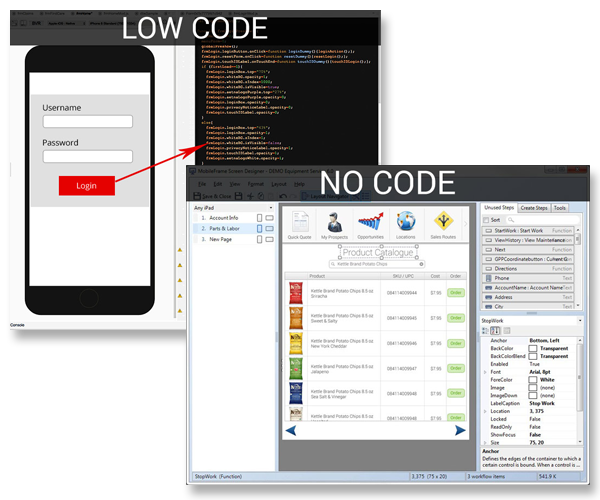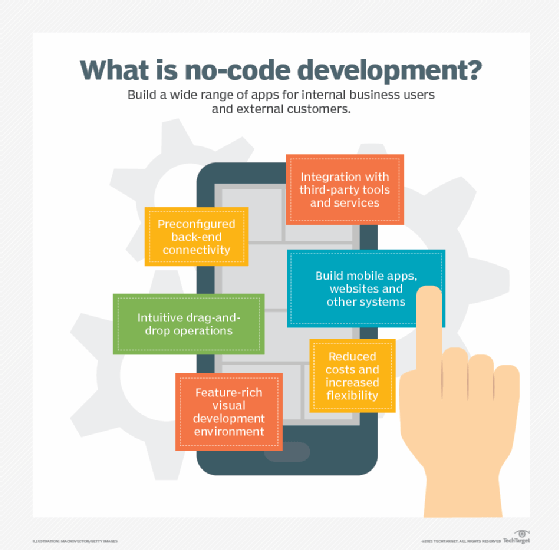New News To Selecting Low-Code Platform Recommendations
New News To Selecting Low-Code Platform Recommendations
Blog Article
The Advantages Of Low-Code Development For Developing Applications As It Is Related To Integration Capabilities
Low-code integration of applications has many advantages, including the ability to seamlessly integrate different systems and services. Here are key benefits from pre-built connectors, APIs, as well as other tools:
A Wide Range of Connectors: Low-code platforms usually come with a large library of pre-built connectors to common enterprise software (e.g. ERP CRM, databases, as well as cloud-based services). This makes it easier for connecting these systems.
API Integration - Many low-code platforms come with API integration, which gives developers easy access to external services or data sources.
Easy of use:
Drag-and-Drop Interfaces: A variety of integration tasks can be easily accomplished using drag-and-drop interfaces. This makes it possible for developers and other non-developers alike to create complex systems without extensive coding.
Visual Workflow builders: These visual tools are designed to create workflows, data flow, and integrations. They assist in understanding and setting up workflows more easily.
Standardized Integration Methods:
SOAP and RESTful Service: Support for standard web services protocols like SOAP and REST allows for easy integration with a array of external software and systems.
OData Standards: OData standards allow for easy manipulation and accessibility of data across various platforms and apps.
Real-Time Data Synchronization:
Real-Time Integrations: Low-code platforms are able to handle real-time synchronization between data applications, systems and databases. This will ensure that the data is always up-to date and consistent throughout an company.
Event-Driven Architectures: Some platforms offer event-driven architectures that enable applications to respond in real-time whenever events occur, which is vital for applications that are dynamic.
Legacy System Integration:
Interconnecting Old and New Systems Low-code platforms usually include tools for integration with older systems, allowing companies to modernize their IT infrastructure without completely overhauling the existing system.
Data Migration Tools - Built-in data-migration tools allow you to transfer data from older systems to low-code applications.
Integration of Third-Party Services:
Integration with Cloud Services: Seamless integration with cloud services such as AWS, Azure, and Google Cloud allows for the easy deployment and scaling of applications.
Business Application Integration: Low-code platforms are able to connect to various business software like Salesforce, SAP, Microsoft Dynamics and more., enabling a cohesive workflow that spans different business functions.
Simple Data Management
Unified Data Models: Some low-code platforms have unification of data models which make it easier to manage data management and integration across different systems.
Data Connectors: Data connectors that are pre-configured to allow easy access to and manipulation of data from various sources.
Security and compliance:
Secure Integrations - Low-code platforms are designed to ensure that all integrations conform to the security standards and protocols. This ensures the security of the data in transit as well as when it is stored.
Compliance Features: These platforms often contain features that ensure integrations meet the requirements of regulatory agencies (e.g. GDPR, HIPAA), providing peace of mind for businesses handling sensitive data.
Extensibility:
Custom Code and Scripts: Low-code platforms are often able to handle more complicated integrations, allowing for the addition of custom scripts and code. This allows for greater flexibility without compromising on the ease of use.
Plug-in Ecosystems. A community of plug-ins and extensions will allow you to further enhance the integration abilities, adding new functionalities whenever needed.
In the end, the integration capabilities of low-code application development platforms makes them an effective device for building connected, efficient, and scalable applications. They allow you to connect various platforms. They also improve the flow of data. See the recommended wavemaker.com coding for more recommendations including app development platform, rapid application design, cross platform mobile development, developing mobile apps, rapid applications, low code development platforms, rapid application design, low code development platforms, paas service, developing mobile apps and more.
Benefits Low-Code Applications In Safety And Governance
Low-code application design offers many advantages when it comes to security and governance. Both are essential for making sure that applications remain compliant, secure and well-managed throughout their entire life cycle. Here are the benefits of low-code application development:
Unified Management Console: A low-code platform typically provides a central dashboard that administrators can use to monitor and manage all apps to ensure consistency in governance throughout the organization.
Role-Based Access Control RBAC (RBAC). These systems typically provide robust access control by role, which gives administrators the ability to define and apply their own access rules. Only authorized users are able to alter or access specific areas of the program.
The Compliance Process and Regulatory Adherence:
Conformity features: A lot of platforms that make use of low-code are constructed to comply to industry standards. They offer templates and tools to ensure that applications comply with these requirements.
Audit trails and logging Audit trails that are comprehensive and logging are usually connected. This allows organizations to keep track of changes and access, as well as to ensure compliance with internal regulations and external ones.
Enhanced Security Measures:
Data Encryption Low-code platforms typically include built-in encryption of data in transit and in rest, securing sensitive data.
Security Certifications Many low-code sellers have security certificates (e.g. ISO 27001, SOC 2 ) that demonstrate the compliance with security standards of high quality. This adds additional confidence to the users.
Automated Security Updates
Regular updates and patches Low code platforms usually are equipped to handle security updates and patches on a regular basis. This means that apps remain protected from the latest threats without the need for developers to manually alter their settings.
Security Monitoring: Continuous security monitoring tools are often included, providing immediate alerts and insight into security concerns that could be a problem.
Data Governance:
Data Access Policies These platforms allow companies to establish data access policies and enforce these policies to ensure that the data is only accessible to users who are authorized. They also make sure that the data is utilized in a proper manner.
Data Masking and Anonymousization The tools built into the system to mask and anonymize data help protect sensitive information in testing and development environments.
Consistent Application Management
Development and deployment pipelines Lowcode platforms usually provide integrated pipelines for development and deployment that include security tests. They ensure security throughout the entire lifecycle of an application.
Version Control: Integrated version control allows for the control of changes. It also ensures that any changes made to the software are tracked, and if needed, reversed. This ensures the security of the program.
User Authentication & Authorization:
Single Sign-On Support for single sign-on (SSO) and other advanced authentication mechanisms makes management easier and improves security.
Multi-Factor Authentication Most platforms come with integrated multi-factor authentication, which adds additional security to accessing applications.
Monitoring of Policy Enforcement and Compliance:
Low-code platforms come with policy templates predefined that can aid organizations in implementing governance policies and security policies.
Compliance Monitoring Tools - These instruments allow for constant monitoring of compliance status and provide reports, making it simple to identify and resolve possible issues.
Integration into Existing Security Infrastructure
Seamless Integration: Low-code systems are designed to work with current security tools and infrastructure, such as identity management systems SIEM (Security Information and Event Management) solutions, and firewalls.
API Security: API security features built-in make it possible to integrate with external systems, securing information and ensuring integrity of the applications.
Training and Best Practices:
Guided Best Practices: Many platforms offer guidelines and best practices for secure application development that help developers who are not developers to adhere to security guidelines.
Security Training: Some providers of low-code provide education and resources in security that will help users understand how to create and maintain secure applications.
The security and governance features of low-code applications ensure that they are developed and maintained in a regulated and compliant way. These platforms offer the frameworks and tools required to safeguard sensitive data and enforce policies, while ensuring the regulatory compliance. Take a look at the recommended Enterprise application development with Low-code Platform for more advice including application development platforms, database in azure, software for app development, mobile app development platforms, rapid application design, rad development, stored sql procedures, mobile app development platforms, rapid applications, azure sql server and more.
Advantages Of Low-Code Application Development In Terms Of Vendor Support And Community
Low-code platform development offers significant advantages, including support from vendors and a community. This is vital for ensuring the success of application implementation along with ongoing maintenance and continual improvement. Here are some key benefits.
Comprehensive Technical Support:
Support Teams: Most platforms that make use of low-code offer special support teams that assist with technical problems as well as troubleshooting and advice.
Some vendors offer 24/7 support. This is useful for companies that operate across time zones.
Training and Onboarding
Training programs that are structured: Vendors offer structured training courses, such as webinars or courses for certification. This helps users to quickly grasp the platform.
Personalized Onboarding: Many vendors offer personalized onboarding to assist new customers implement the platform in a way that is effective and customize it to their particular requirements.
Regular Updates, Enhancements and Improvements:
Continuous Improvement: Low code platform providers regularly release updates that include new features, security patches and improvements to performance. This ensures that the platform will always be updated and safe.
Feedback Integration Vendors integrate user feedback into the process of development to ensure that the platform evolves to meet changing needs.
Comprehensive Documentation:
The Documentation In Detail: Users can find answers to their problems by consulting an organized and detailed manual that covers all aspects of the software beginning with its fundamental functionality to more advanced modifications.
API References API documentation can aid developers to customize and integrate their applications with the Low-Code platform.
Consultation and Professional Services:
Expert Consultation: A number of companies offer consulting services to assist users in complex implementations and architecture designs and also strategic planning.
Custom Development Services Some vendors offer custom development services to create specific functions and integrations that are not included in standard.
Community Support for the Community
Active User Community:
Discussion boards and forums: Many low-code platforms offer lively online communities that allow users to discuss ideas, discuss questions and collaborate.
User Groups and Meetups User Groups and Meetups: Local or virtual groups and meetings provide opportunities to learn, network and sharing experiences.
Knowledge Sharing and Collaboration:
Community-Contributed Resources: Users often share templates, modules, and extensions that they have developed, which can be reused or adapted by others, accelerating development and innovation.
Crowdsourced Solutions: The collective knowledge, experience and expertise of a community can be an effective tool for troubleshooting and finding creative solutions.
Learning and Development:
Community-Led Learning: Several communities host training sessions, workshops and webinars that are often led by users with experience who can share their knowledge and more advanced methods.
Online Tutorials and Courses: Community members often create and distribute online tutorials, courses, and how-to guides, making better educational resources available to all users.
Feedback and Influence
Product Feedback Channels. Community forums typically include channels that allow users to give feedback to the manufacturer. Feedback from customers can influence the development and improvement of features.
Beta Testing Active communities might be eligible to take part. This allows them to get early access to the platform and participate in the design of the platform.
Recognition and Encouragement
Community Recognition Programmes: Many vendors offer recognition programs for active community members. Examples include MVP (Most Valuable Professionals) which acknowledges their contribution of community members.
Peer Support Community members typically offer support to other members by sharing their expertise and offering guidance to users who are less experienced. This helps create a more collaborative and supportive atmosphere.
Overall, the combination of robust support from the vendor and an active connected community offers an extensive support system for the development of low-code applications. The combination of robust vendor support and an active and engaged community creates a comprehensive support ecosystem for development of low-code applications.